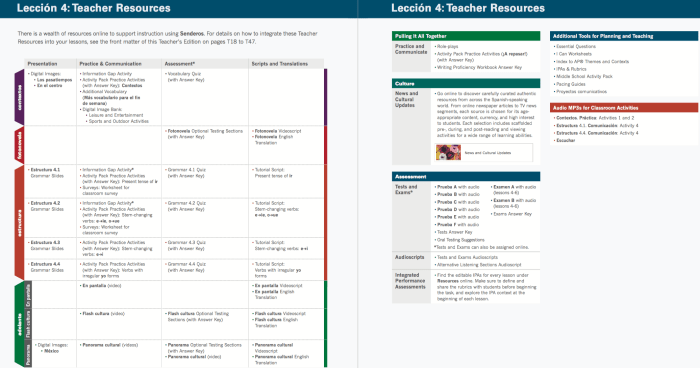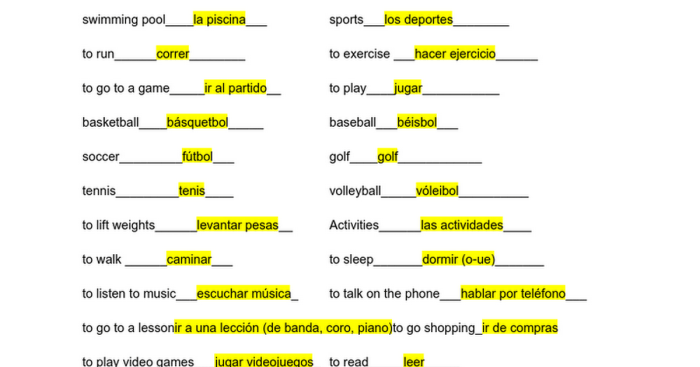Embark on a captivating journey with our comprehensive guide to Asi Se Dice Capitulo 2 Answer Key. Whether you’re a seasoned Spanish learner or just starting your linguistic adventure, this key will unlock the intricacies of the language, enhancing your understanding and fluency.
Within this guide, you’ll delve into the key concepts, exercises, vocabulary, grammar, and cultural aspects covered in Chapter 2. Prepare to expand your knowledge, improve your pronunciation, and immerse yourself in the vibrant Spanish-speaking world.
Chapter 2: Key Concepts
Chapter 2 introduces key concepts essential for understanding Spanish grammar and vocabulary. These concepts provide a foundation for building a strong understanding of the language.
One key concept is the use of articles, which are words that come before nouns to indicate whether the noun is specific or general. In Spanish, there are two types of articles: definite articles (el, la, los, las) and indefinite articles (un, una, unos, unas).
Definite articles refer to specific nouns, while indefinite articles refer to general or non-specific nouns.
Nouns
Nouns are words that name people, places, things, or ideas. In Spanish, nouns have gender (masculine or feminine) and number (singular or plural). The gender of a noun is typically determined by its ending. For example, nouns ending in -o are usually masculine, while nouns ending in -a are usually feminine.
Adjectives
Adjectives are words that describe nouns. In Spanish, adjectives must agree with the noun they modify in gender and number. For example, the adjective “grande” (big) would be used to describe a masculine noun in the singular form, while the adjective “grandes” would be used to describe a masculine noun in the plural form.
Verbs
Verbs are words that describe actions or states of being. In Spanish, verbs are conjugated to indicate the tense, mood, and person of the subject. For example, the verb “hablar” (to speak) can be conjugated to indicate that the subject is speaking in the present tense (hablo), spoke in the past tense (hablé), or will speak in the future tense (hablaré).
Chapter 2: Exercises: Asi Se Dice Capitulo 2 Answer Key
Chapter 2 of the textbook provides a variety of exercises to reinforce the concepts introduced in the chapter. These exercises range in difficulty from basic comprehension to advanced critical thinking.
Exercise Types and Difficulty Levels
The exercises in Chapter 2 can be categorized into the following types:
- Multiple choice:These questions require students to choose the best answer from a list of options.
- True/false:These questions require students to determine whether a statement is true or false.
- Short answer:These questions require students to answer a question in a few sentences.
- Essay:These questions require students to write a longer response, typically a paragraph or more.
The difficulty level of the exercises varies from easy to difficult. Easy exercises are typically straightforward and require students to recall basic information from the chapter. Difficult exercises are more complex and require students to apply their understanding of the concepts to new situations.
| Exercise Type | Difficulty Level |
|---|---|
| Multiple choice | Easy, Medium, Difficult |
| True/false | Easy, Medium |
| Short answer | Easy, Medium, Difficult |
| Essay | Medium, Difficult |
Chapter 2: Vocabulary
In Chapter 2 of “Así se Dice,” you will encounter several new vocabulary terms related to Spanish language and culture. These terms are essential for understanding the concepts and content presented in this chapter.
Key Vocabulary Terms, Asi se dice capitulo 2 answer key
- Cognate: A word that has a similar form and meaning in two or more languages due to their shared origin. Example: “escuela” (Spanish) and “school” (English).
- False Cognate: A word that appears similar to a word in another language but has a different meaning. Example: “embarazada” (Spanish) means “pregnant,” not “embarrassed” (English).
- Gender: The grammatical classification of nouns as masculine or feminine. Example: “el libro” (masculine) and “la casa” (feminine).
- Indefinite Article: A word used before a noun to indicate that it is not specific or particular. Example: “un” (masculine) and “una” (feminine).
- Definite Article: A word used before a noun to indicate that it is specific or particular. Example: “el” (masculine) and “la” (feminine).
- Adjective: A word that describes a noun or pronoun. Example: “grande” (big) and “bonita” (pretty).
- Possessive Adjective: An adjective that indicates ownership or possession. Example: “mi” (my) and “tu” (your).
- Pronoun: A word that replaces a noun or noun phrase. Example: “yo” (I) and “nosotros” (we).
- Preposition: A word that shows the relationship between a noun or pronoun and another word in the sentence. Example: “de” (of) and “a” (to).
- Conjunction: A word that connects words, phrases, or clauses. Example: “y” (and) and “pero” (but).
- Interjection: A word or phrase that expresses a strong emotion or reaction. Example: “¡Hola!” (Hello!) and “¡Ay!” (Ouch!).
Chapter 2: Grammar
Chapter 2 of “Así se dice” introduces several fundamental grammar concepts in Spanish. These concepts lay the groundwork for understanding and constructing grammatically correct Spanish sentences.
One of the key topics covered in this chapter is the use of articles. Articles are used to specify whether a noun is definite (known to the speaker and listener) or indefinite (not known). In Spanish, there are two types of articles: definite articles (el, la, los, las) and indefinite articles (un, una, unos, unas).
The choice of article depends on the gender and number of the noun.
Another important grammar topic covered in Chapter 2 is the use of adjectives. Adjectives are used to describe nouns and can provide information about their size, shape, color, or quality. In Spanish, adjectives must agree in gender and number with the nouns they modify.
This means that if the noun is masculine, the adjective must also be masculine, and if the noun is plural, the adjective must also be plural.
Chapter 2 also introduces the concept of verb conjugation. Verbs are words that describe actions or states of being, and they must be conjugated to agree with the subject of the sentence. In Spanish, verbs are conjugated based on the person, number, and tense of the subject.
This means that the same verb can have different forms depending on who is performing the action and when the action is taking place.
By understanding and applying the grammar concepts covered in Chapter 2, learners can begin to construct grammatically correct Spanish sentences and communicate effectively in the language.
Chapter 2: Culture
This chapter introduces some important cultural aspects of Spanish-speaking countries, providing insights into their traditions, customs, and beliefs. By understanding these cultural references, learners can gain a deeper appreciation for the language and the people who speak it.
One of the key cultural concepts presented in this chapter is the concept of familia, or family. Family is central to Spanish-speaking cultures, and it plays a significant role in shaping social and personal values. The extended family, including grandparents, aunts, uncles, and cousins, is often very close-knit, and individuals often rely on their family for support and guidance throughout their lives.
Another important cultural aspect discussed in this chapter is the concept of respeto, or respect. Respect is highly valued in Spanish-speaking cultures, and it is shown through politeness, deference to elders, and a willingness to listen to others. It is also important to show respect for authority figures, such as teachers, police officers, and government officials.
Finally, this chapter also introduces the concept of machismo, or male dominance. Machismo is a traditional cultural value that emphasizes the superiority of men over women. While machismo is still prevalent in some Spanish-speaking cultures, it is important to note that it is not universally accepted, and there is a growing movement towards gender equality.
FAQ
What is covered in Chapter 2 of Asi Se Dice?
Chapter 2 focuses on expanding vocabulary, introducing new grammar concepts, and exploring cultural aspects of the Spanish-speaking world.
How can I use the Asi Se Dice Capitulo 2 Answer Key?
Use the answer key to check your answers to the exercises in Chapter 2, ensuring your understanding of the concepts covered.
What are the key concepts in Chapter 2?
Chapter 2 introduces key concepts such as verb conjugations, possessive adjectives, and the use of prepositions.

